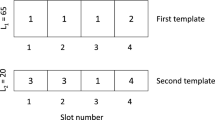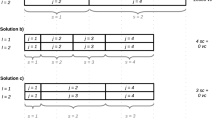This paper presents a constraint network approach to the design and manufacture of high-variety labels. The existing approach to label printing in the industry is essentially a sequential approach. In this approach, layout sheet utilization is optimized based on label attributes only. Production then attempts to meet delivery date of the labels by first processing high-priority labels from the layout sheet, and others later. This results in huge work-in-process inventory and high production cost. In this paper, we propose a constraint network approach to the design and manufacture of labels on layout sheets. Mathematical models of the various manufacturing stages are considered in the design process. Thus the emerging optimal layout design minimizes the work-in-process inventory and production cost, and maximizes production efficiency. The algorithm is an application of artificial intelligence techniques in a system domain. An example application of the algorithm results in an efficient production schedule and greater product delivery performance.
Similar content being viewed by others
References
Adamowicz, M. and Albano, A. (1986) A solution for the rectangular cutting-stock problem. IEEE Transactions on Systems, Man, and Cybernetics, 6, 302–310.
Agrawal, P. K. (1993) Minimizing trim loss in cutting rectangular blocks of a single size from a rectangular sheet using orthogonal guillotine cuts. European Journal of Operational Research, 64(3), 410–422.
Albano, A. andSappupo, G. (1980) Optimal allocation of two-dimensional irregular shapes using heuristic search method. IEEE Transactions on System, Man, and Cybernetics, 10, 242.
Arbel, A. (1993) Large-scale optimization methods applied to the cutting stocks problem of irregular shapes. International Journal of Production Research, 31(2), 483–500.
Ardayfio, D. D., Carlson, A. C. and Marcell, R. P. (1992) Application of DFMA in automotive vehicle development, in Proceedings of the National Design Engineering Conference, 92-DE-7. ASME, New York.
Bookbinder, J. H. and Higginson, J. K. (1986) Customer service vs trim waste in corrugated box manufacture. Journal of Operations Research Society, 37(11), 1061–1071.
Christofides, N. and Whitlock, C. (1977) An algorithm for two-dimensional cutting problems. Operations Research, 25, 30–34.
Creese, R. C. and Moore, L. T. (1990) Cost modeling for concurrent engineering, Cost Engineering, 32(6), 23–27.
Dechter, R. and Pearl, J. (1988) Network-based heuristics for constraint-satisfaction problems. Artificial Intelligence, 34.
Dietrich, R. D. and Yakowitz, S. J. (1991) A rule-based approach to the trim-loss problem. International Journal of Production Research, 29(2), 401–415.
Evans, B. (1988) Simultaneous engineering. Mechanical Engineering, 110(4), 38–40.
Fohn, S. M., Greef, A., Young, R. E. and O'Grady, P. (1994) A constraint-based approach to AS/RS design, in Proceedings of 3rd Industrial Engineering Research Conference, pp. 473–478. IIE, Norcross, GA.
Golden, B. (1976) Approaches to cutting stock problem. AIIE Transactions, 8, 265–274.
Hartley, J. R. (1992) Concurrent Engineering: Shortening Lead Times, Raising Quality and Lowering Costs. Productivity Press, Cambridge, MA.
Israni, S. and Sanders, J. (1982) Two-dimensional cutting-stock problem research: a review and a new rectangular layout algorithm. Journal of Manufacturing Systems, 1, 169–182.
O'Grady, P., Young, R. E. and Greef, A. (1992) An artificial intelligence-based constraint network system for concurrent engineering. International Journal of Production Research, 30(7), 1715–1735.
O'Grady, P. and Young, R. E. (1991) Issues in concurrent engineering systems. Journal of Design and Manufacturing, 1, 27–34.
Okogbaa, O. G. and Vaiyapuri, V. (1993) An integrated design approach for feature based manufacturing using concurrent engineering, in Proceedings of the 2nd Industrial Engineering Conference, pp. 16–20. IIE, Norcross, GA.
Singh, N. and Wang, M. H. (1994) Concurrent engineering in a high variety label printing environment. International Journal of Production Research, 32(7), 1675–1691.
Singh, N. and Sushi (1990) A physical system theory framework for modeling manufacturing systems. International Journal of Production Research, 28(6) 1067–1082.
Turino, J. (1991) Making it work calls for input from everyone. Concurrent Engineering: special issue, IEEE Spectrum, July, pp. 22–37.
Wang, P. (1983) Two algorithms for constrained two-dimensional cutting stock problems. Operations Research, 31, 573–586.
Wheeler, R., Burnett, R. W. and Rosenblatt, A. (1991) Concurrent engineering: success stories in instrumentation, communications. IEEE Spectrum, 28(7), 32–37.
Winston, P. H. (1992) Artificial Intelligence, 3rd edn, Addison-Wesley, Reading, MA.
Author information
Authors and Affiliations
Rights and permissions
About this article
Cite this article
Awofala, A.O., Singh, N. Constraint network approach to the design and manufacture of labels in a high-variety label-printing environment. J Intell Manuf 7, 499–514 (1996). https://doi.org/10.1007/BF00122839
Issue Date:
DOI: https://doi.org/10.1007/BF00122839




